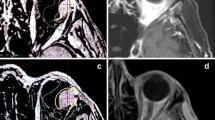Abstract
Purpose
This study was performed in order to evaluate the incidence of radiation retinopathy and optic neuropathy occurring after proton beam therapy for uveal melanoma.
Methods
Included in this study were all patients who had been treated with primary proton beam therapy for uveal melanoma at the oncology service between May 1998 and June 2014 with a minimum follow-up of 12 months. Excluded were all patients who underwent re-irradiation, or vitrectomy due to exudative retinal detachment or for tumor-resection.
Results
During this period, 1127 patients matched the inclusion criteria, of whom 768 (68.1 %) and 463 (41.0 %) developed radiation retinopathy and optic neuropathy after a median time of 18.9 months (2.0–99.84 months) and 19.8 months (0.2–170.4 months), respectively. Mean follow-up was 53.4 months (12–170.4 months). Included were 558 men (49.5 %) and 569 women (50.5 %). Mean age was 61 years (16–89 years). Visual acuity slightly decreased from initial levels of 0.3 logMAR–0.4 logMAR in patients without developing any radiation-induced complication but severely decreased to 1.0 logMAR or 1.5 logMAR in the case of developing radiation retinopathy only or optic neuropathy, respectively. Independent risk factors for radiation retinopathy were a centrally (<2.5 mm from sensitive structures) located tumor or a thick tumor located more than 2.5 mm from sensitive structures, while those for radiation optic neuropathy comprised a short distance and applied dose to the optic disk.
Conclusion
The risk for radiation retinopathy is higher in central uveal melanoma.
Mid-/peripheral tumors are at high risk for radiation retinopathy and maculopathy if presenting with increased thickness.


Similar content being viewed by others
References
Denker A, Cordini D, Heufelder J et al (2007) On accelerator applications in medicine and cultural heritage. Nucl Inst Methods Phys Res A 580:457–461
Goitein M, Miller T (1983) Planning proton therapy of the eye. Med Phys 10(3):275–83
Dobler B, Bendl R (2002) Precise modelling of the eye for proton therapy of intra-ocular tumours. Phys Med Biol. 21;47(4):593–613
Brown GC, Shields JA, Sanborn G et al (1982) Radiation retinopathy. Ophthalmology 89:1489–1493
Gündüz K, Shields CL, Shields JA et al (1999) Radiation retinopathy following plaque radiotherapy for posterior uveal melanoma. Arch Ophthalmol 117:609–614
Bechrakis NE, Foerster MH (2006) Neoadjuvant proton beam radiotherapy combined with subsequent endoresection of choroidal melanomas. Int Ophthalmol Clin 46:95–107
Seibel I, Cordini D, Willerding G et al (2015) Endodrainage, tumor photocoagulation, and silicone oil tamponade for primary exudative retinal detachment due to choroidal melanoma persisting after proton beam therapy. Ocul Oncol Pathol 1:24–33
Riechardt AI, Cordini D, Willerding GD et al (2014) Proton beam therapy of parapapilllary choroidal melanoma. Am J Ophthalmol 157:1258–1265
Sagoo MS, Shields CL, Emrich J et al (2014) Plaque radiotherapy for juxtapapillary choroidal melanoma: treatment complications and visual outcomes in 650 consecutive cases. JAMA Ophthalmol 132:697–702
Finger PT (2000) Tumour location affects the incidence of cataract and retinopathy after ophthalmic plaque radiation therapy. Br J Ophthalmol 84:1068–1070
Egbert PR, Fajardo LF, Donaldson SS et al (1980) Posterior ocular abnormalities after irradiation for retinoblastoma: a histopathological study. Br J Ophthalmol 64:660–665
Archer D Doyne Lecture (1993) response of retinal and choroidal vessels to ionizing radiation. Eye 71–113
Kinyoun JL (2008) Long-term visual acuity results of treated and untreated radiation retinopathy (an AOS thesis). Trans Am Ophthalmol Soc 106:325–335
Kim IK, Lane AM, Egan KM et al (2010) Natural history of radiation papillopathy after proton beam irradiation of parapapillary melanoma. Ophthalmology 117:1617–22
Finger PT, Chin KJ, Yu GP et al (2010) Palladium-103 for Choroidal Melanoma Study G, Risk factors for radiation maculopathy after ophthalmic plaque radiation for choroidal melanoma. Am J Ophthalmol 149:608–615
Damato BE (2012) Local resection of uveal melanoma. Dev Ophthalmol 49:66–80. doi:10.1159/000328261.Epub2011
Jager MJ, Desjardins L, Kivelä T et al (2012) Current Concepts in Uveal Melanoma. Dev Ophthalmol Basel, Karger 49:41–57
Schönfeld S, Cordini D, Riechardt AI et al (2014) Proton beam therapy leads to excellent local control rates in choroidal melanoma in the intermediate fundus zone. Am J Ophthalmol 158:1184–91
Gragoudas ES, Li W, Lane AM et al (1999) Risk factors for radiation maculopathy and papillopathy after intraocular irradiation. Ophthalmology 106:1572–1578
Hayreh SS (2015) Ocular vascular occlusive disorders. Blood supply of the optic nerve head, vol 5. Springer International Publishing, Switzerland, pp 103–110
Acknowledgments
Statistical analysis was performed by Dr. Ulrich Gauger, medical statistician, Berlin, Germany
Author information
Authors and Affiliations
Corresponding author
Ethics declarations
Funding
No funding was received for this research
Conflict of interest statement
Prof. A. Joussen and Dr. M. Rehak report personal fees from Bayer, personal fees from Novartis, and personal fees from Allergan, outside the submitted work. All other authors certify that they have no affiliations with or involvement in any organization or entity with any financial interest (such as honoraria; educational grants; participation in speakers’ bureaus; membership, employment, consultancies, stock ownership, or other equity interest; and expert testimony or patent-licensing arrangements), or non-financial interest (such as personal or professional relationships, affiliations, knowledge or beliefs) in the subject matter or materials discussed in this manuscript.
Ethical approval
All procedures performed in studies involving human participants were in accordance with the ethical standards of the institutional and/or national research committee and with the 1964 Helsinki declaration and its later amendments or comparable ethical standards. For this type of study formal consent is not required.
Rights and permissions
About this article
Cite this article
Seibel, I., Cordini, D., Hager, A. et al. Predictive risk factors for radiation retinopathy and optic neuropathy after proton beam therapy for uveal melanoma. Graefes Arch Clin Exp Ophthalmol 254, 1787–1792 (2016). https://doi.org/10.1007/s00417-016-3429-4
Received:
Revised:
Accepted:
Published:
Issue Date:
DOI: https://doi.org/10.1007/s00417-016-3429-4




